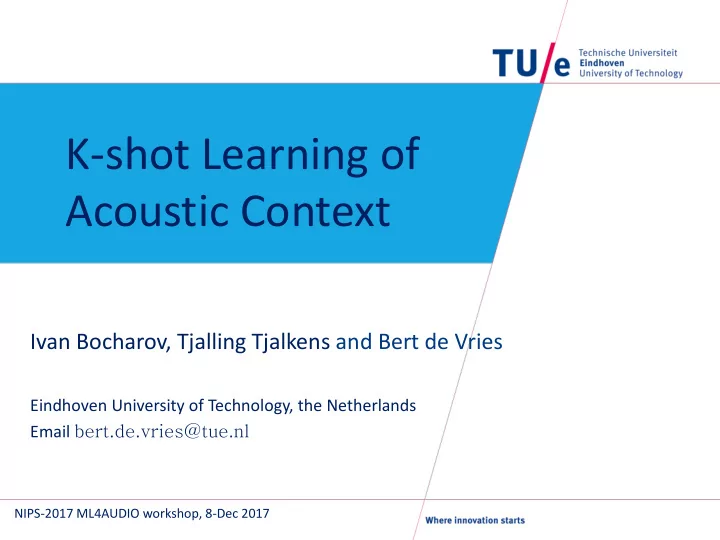

K-shot Learning of Acoustic Context Ivan Bocharov, Tjalling Tjalkens and Bert de Vries Eindhoven University of Technology, the Netherlands Email bert.de.vries@tue.nl NIPS-2017 ML4AUDIO workshop, 8-Dec 2017
Use Case / Problem Statement
Approach: probabilistic modeling ACOUSTIC MODEL SPECIFICATION – Define a generative probabilistic model for acoustic signals that contains scenes as latent states. TRAINING 1. “Representation training”: Unsupervised offline training on a large database of acoustic signals across many scenes 2. Train new scenes : Continue with supervised training on an online recorded small set of scene-labeled waveforms CLASSIFICATION – Goal: assign future streaming acoustic data to the correct (or similar) scenes 5
(Mixture of) Hidden Semi-Markov Models small, hierarchically structured, 𝑑 scenes (“classes”) ∫ with duration modeling HSMM 𝑑 = 1, … , 𝐷 𝜄 segments (s) 𝑨 0 𝑨 1 𝑨 1 𝑨 𝐿 𝑒 𝐿 𝑒 1 𝑒 2 features (60 MFCC per 40 ms 20 ms hop) 𝑦 1 ∫ ∫ ∫ 𝑦 𝑗=1 𝐿 𝑒 𝑗 𝑦 𝑒 1 𝑦 𝑒 1 +1 𝑦 𝑒 1 +𝑒 2 𝑦 𝑗=1 𝐿−1 𝑒 𝑗 +1 samples
generative model: dynamics: parameters: class prior:
Data set: TUT Acoustic Scenes 2016 • Collected by Tampere University of Technology • 15 acoustic scenes • ~40 min. of audio per class Data Preparation • Data set 1 : draw one example (30secs) from each of 11 randomly chosen scenes • Data set 2 : draw one example from remaining (4) classes. • Classify : test on remaining examples of data set 2 9
Step 1: Train Duration Models 𝑑 scenes ∫ HSMM 𝑑 = 1, … , 𝐷 𝜄 segments 𝑨 0 𝑨 1 𝑨 1 𝑨 𝐿 𝑒 𝐿 𝑒 1 𝑒 2 𝑦 1 features (MFCC) ∫ ∫ ∫ 𝑦 𝑗=1 𝐿 𝑒 𝑗 samples
Step 1: Train Duration Models 𝑑 scenes ∫ HSMM 𝑑 = 1, … , 𝐷 𝜄 segments 𝑨 0 𝑨 1 𝑨 1 𝑨 𝐿 𝑒 𝐿 𝑒 1 𝑒 2 𝑦 1 features (MFCC) ∫ ∫ ∫ 𝑦 𝑗=1 𝐿 𝑒 𝑗 samples
Duration distributions (initialization Pois(.) ) 14
Duration distributions (after training) 15
Step 2: One-shot Training 𝑑 scenes HSMM 𝑑 = 1, … , 𝐷 𝜄 segments 𝑨 0 𝑨 1 𝑨 1 𝑨 𝐿 𝑒 𝐿 𝑒 1 𝑒 2 𝑦 1 features (MFCC) ∫ ∫ ∫ 𝑦 𝑗=1 𝐿 𝑒 𝑗 samples
Step 2: One-shot Training 𝑑 scenes HSMM 𝑑 = 1, … , 𝐷 𝜄 segments 𝑨 0 𝑨 1 𝑨 1 𝑨 𝐿 𝑒 𝐿 𝑒 1 𝑒 2 𝑦 1 features (MFCC) ∫ ∫ ∫ 𝑦 𝑗=1 𝐿 𝑒 𝑗 samples
Classification 𝑑 ? scenes HSMM 𝑑 = 1, … , 𝐷 𝜄 segments 𝑨 0 𝑨 1 𝑨 1 𝑨 𝐿 𝑒 𝐿 𝑒 1 𝑒 2 𝑦 1 features (MFCC) ∫ ∫ ∫ 𝑦 𝑗=1 𝐿 𝑒 𝑗 samples
Results 21
Summary and Future Plans • Ongoing research on in-situ one-shot learning of a personalized acoustic scene classifier • Use case is hearing aids personalization, but also applicable to urban monitoring, elderly care, etc. • Generative modeling approach, inspired by one-shot learning work of (a.o.) Brendan Lake et al (2014), Matthew Johnson et al. (2013) • An HSMM-based probabilistic classifier shows promising performance on one-shot learning task compared to 1NN-DTW. • Specifically, learned priors for segment duration models parameters helps the classifier to recognize new classes from a single example. • Future work includes more thorough analysis and exploration of competing models. 22
Acknowledgements • Matthew Johnson et al. for Package Pyhsmm (@ https://github.com/mattjj/pyhsmm) Thank you
Recommend
More recommend